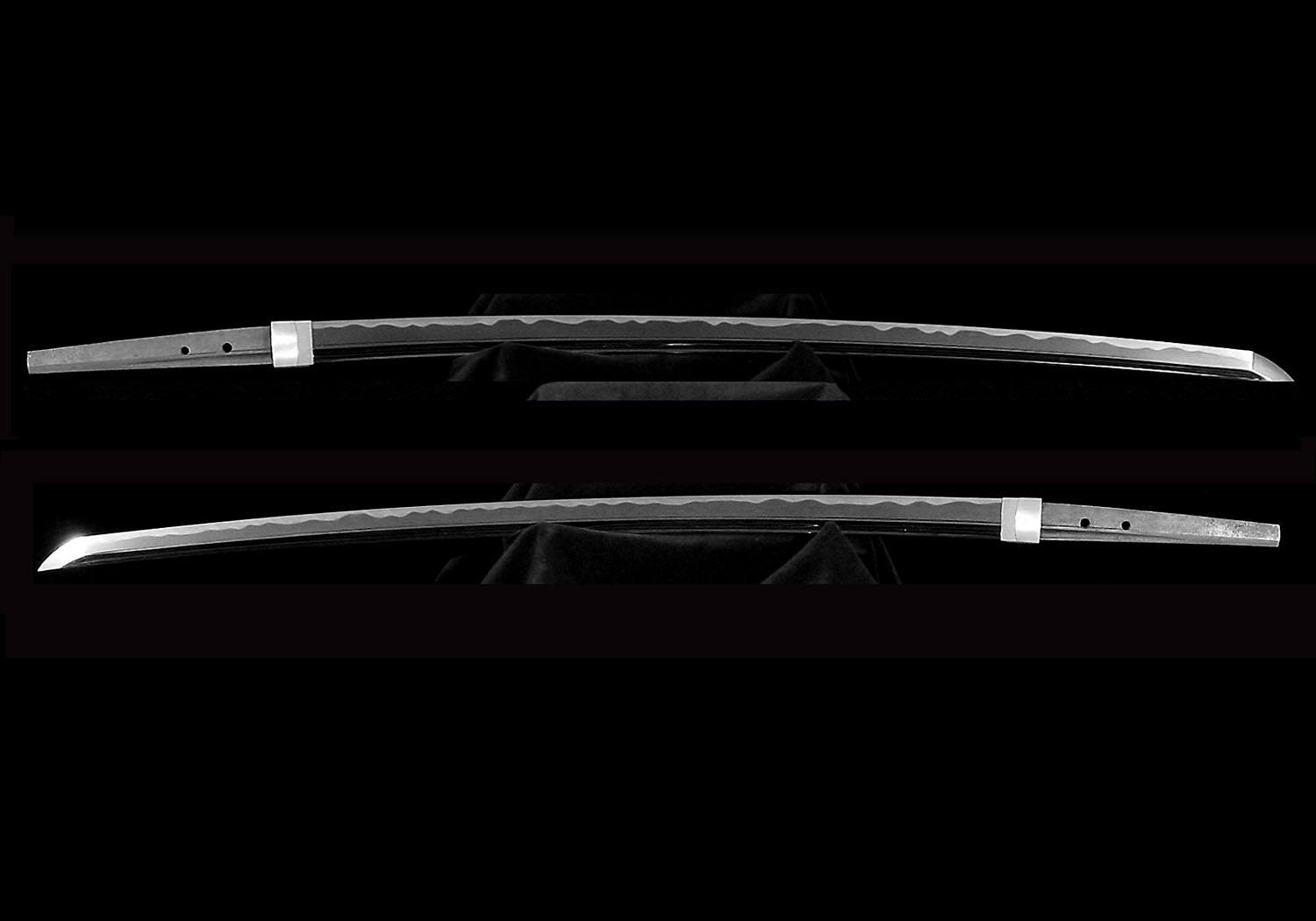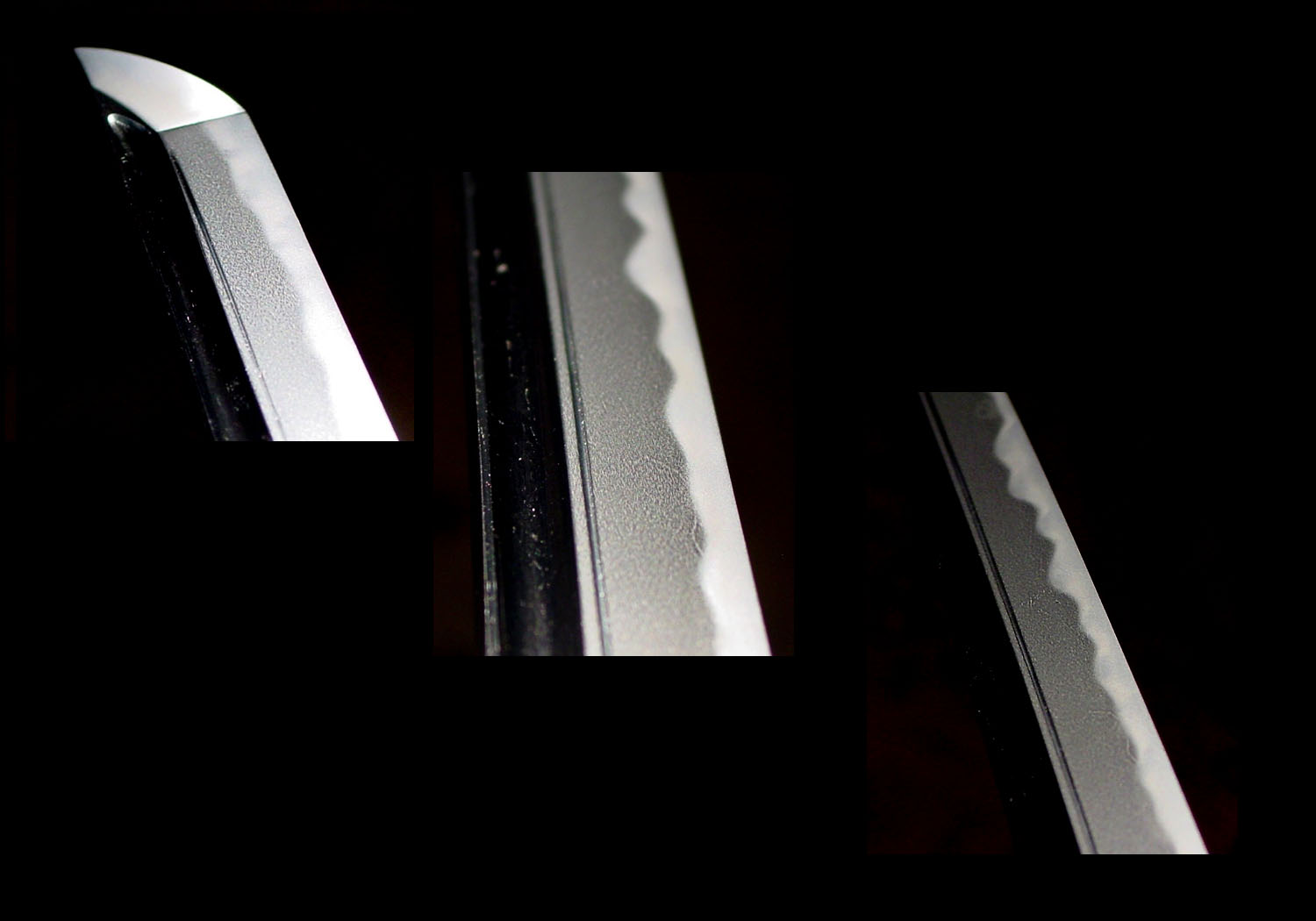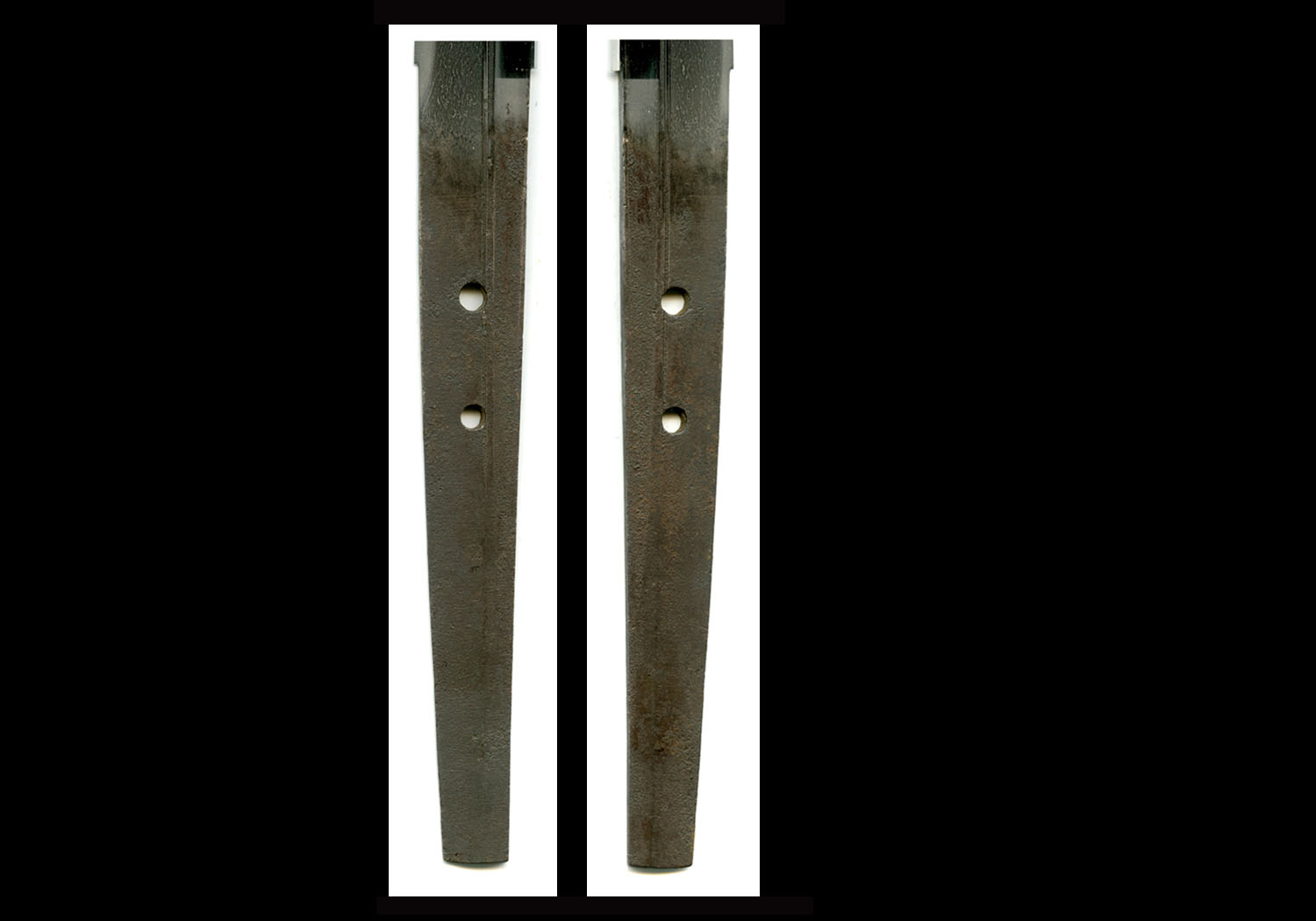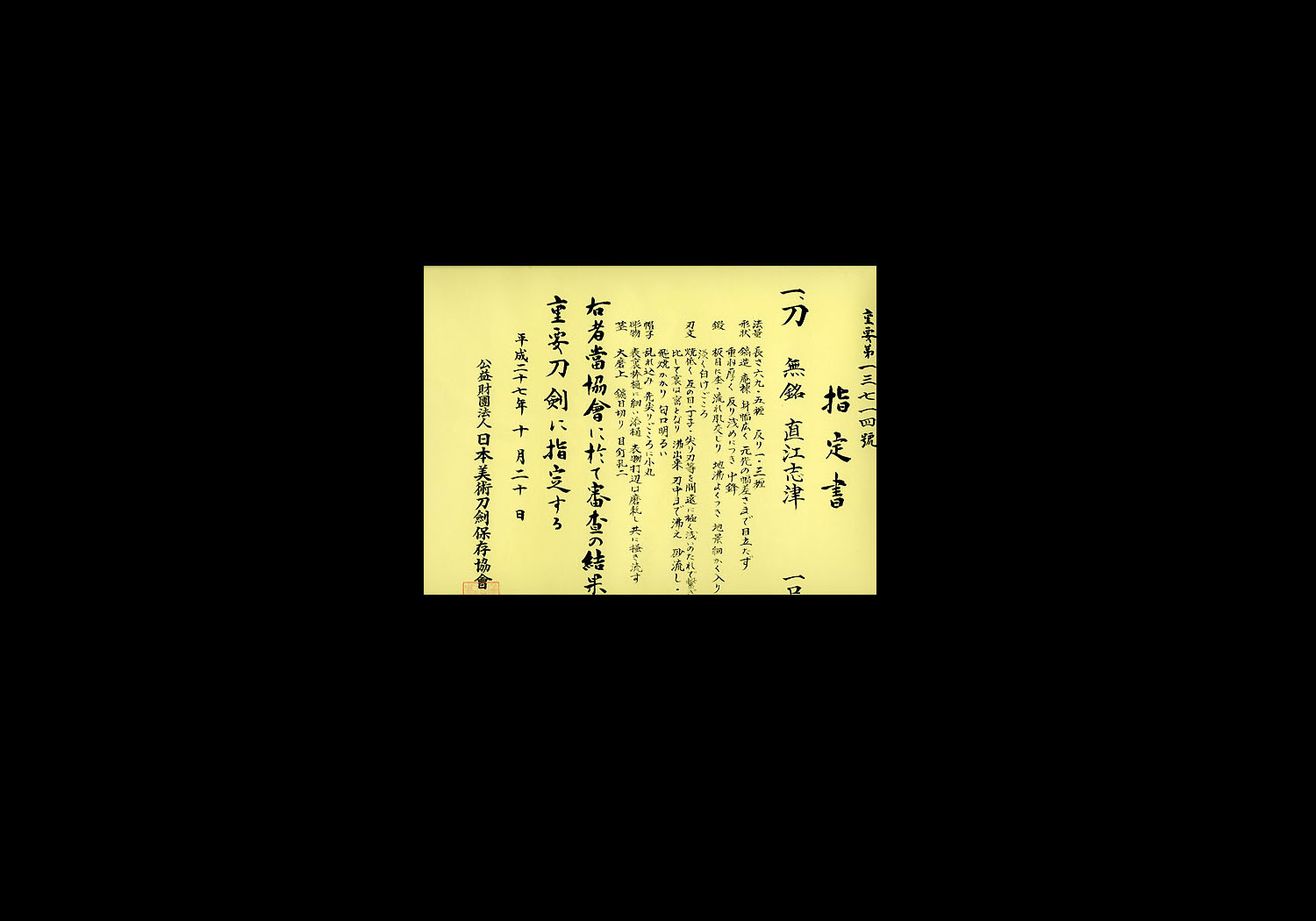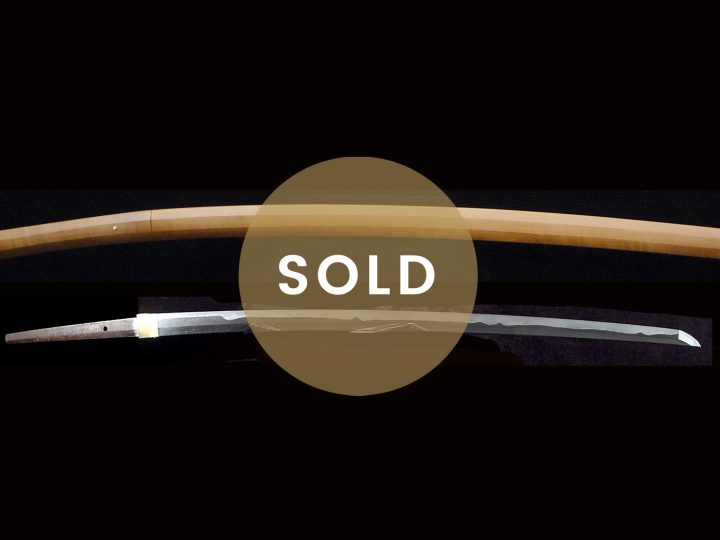
This is a beautiful and graceful tachi that has been shortened to katana length. It was awarded Juyo Token status as belonging to the Naoe Shizu school. It has a cutting edge of 27 5/16 inches or 69.5 cm. The moto-haba is 1.21 inches or 3.0 cm and the saki-haba is 0.85 inches or 2.2 cm.
The end of the Kamakura era brought two important sword smiths to Mino Province, Kaneuji and Kinju. Kaneuji came from the Yamato Tegai school of Yamato province and Kinju moved to Mino from Echizen province. Kaneuji studied under Masamune and became one of the famous Masamune Juttetsu. After studying with Masamune, he moved to Mino and established a forge in the town of Shizu. He produced swords from the end of the Kamakura era into the Nanbokucho era. His style of workmanship is very close to Masamune. His kitae is very fine resulting in a texture of ko-mokume with some masame hada in places. There is an abundance of ji-nieresulting in yubashiri and chikei in areas. Masame hada will be especially noticeable in the shinogi-ji.
In the middle of the Nanbokucho era, Kanetomo, Kanetsugu, and Kanenobu, three students of Shizu Saburo Kaneuji, moved from Shizu to establish their forge at Naoe in Mino and this became known as the Naoe Shizu group of smiths. Smiths in this group continued to produce swords through the early Muromachi era. Naoe Shizu workmanship is different from that of Kaneuji in that the sugata is grander than Kaneuji’s, the jihada has more masame combined within it, the jigane is whitish, and the hamon is mixed with considerable togari gunome.
This blade certainly exhibits the grand sugata of the Nanbokucho era with a wide mihaba and a jitetsu of flowing itame mixed with ko-mokume with an area of o-mokume here and there. The jitetsu is bright and clear. There is probably strong masame hada in the ji, but the bo-hi and soe-hi effectively hide it . The hamon is an o-midare with many areas of togari-ba and contains ashi and yo. The boshi is somewhat large but not reaching the proportions of the traditional Nanbokucho o-kissaki that would come later in the Nanbokucho era.
This blade was recently awarded Juyo Token status by the NBTHK and the certificate will be forwarded to the new owner when it is published later this year.
The translation of the Juyo zufu is as follows:
Designated Juyo Token at the 61st Shinsa of 20 October, the 27th year of Heisei (2015)
Katana, Unsigned; Naoe Shizu
Measurements: Length: 69.5 cent.; Curvature: 1.3; Width at Base: 3.0 cent.; Width at Point: 2.2 cent.; Length of Point: 3.2; Nakago Length: 19.7 cent.; Nakago Curvature: 0.3.
Characteristics: The construction is shinogi-zukuri with an iori-mune. The blade is wide, and there is a conspicuous difference between the width at the base and the point. The blade is thick, the curvature is shallow, and there is a chu-kissaki. The kitae is itame with mokume, and a mixing in of flowing hada. The kitae is well covered in ji-nie, and the jigane contains minute chikei with faint shirake style ji-utsuri. The hamon is tempered low on the blade, and is an extremely shallow notare connected with such shapes as gunome, choji and togari-ba at intervals. The ura hamon is comparatively busy. The habuchi is nie based with the nie covering down to the middle of the ha. There are streaks of sunagashi and tobiyaki with a bright nioiguchi. The boshi is midare-komi with a slightly pointed tip and ko-maru. There are bohi carvings on both sides of the blade with narrow soe-bi. The omote soe-bi near the monouchi has been polished away, and both grooves taper off onto the nakago. The nakago is o-suriage, the tip is kiri, and the yasuri are kiri. There are two mekugi-ana, and the blade is unsigned.
Explanation: Kaneuji, who is counted as one of the ten disciples of Masamune, resided in the Shizu area of Mino Province, and after the school prospered, such of his students as Kanetomo, Kanetsugu, Kaneshige and Kanenobu moved to Naoe in the same province, to make swords. This group of sword-smiths as a whole is generally referred to as the Naoe Shizu.
As for this katana, the blade is wide and thick with a robust shape. The kitae is itame and mokume with a mixing in of flowing hada that is well covered in ji-nie. The jigane contains minute chikei. The style of the hamon is an extremely shallow notare with a connection of such shapes as gunome, choji and togari-ba. Within this same school, this type of hamon is symbolic of the group, which makes this attribution highly persuasive. The nie covering extends to the middle of the ha, and there are streaks of sunagashi with tobiyaki. Here and there, coarse nie can be seen, making this a highly ambitious work. The boshi is also a powerful midare-komi. Both the ji and the ha are bright, making this a highly rewarding work, and within this same school, it is a masterpiece.
PRICE: SOLD


